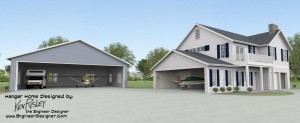 For pilots, living with your airplane and living in a hangar home is a dream that they may have had for many years. Most never do it, but those who do are in for a lifestyle like no other they have experienced. Hangar homes are unique. If you're looking to design and build one, here is a checklist of some of the items that you will want to keep in mind prior to and during the design.
For pilots, living with your airplane and living in a hangar home is a dream that they may have had for many years. Most never do it, but those who do are in for a lifestyle like no other they have experienced. Hangar homes are unique. If you're looking to design and build one, here is a checklist of some of the items that you will want to keep in mind prior to and during the design. 1.Most aviation communities have architectural covenants. It is important to know these rules. Many are unique to these types of communities such as issues regarding street sign heights, taxiway clearance and the like. Most covenants include requirements for sizes of the homes and even the hangars themselves. Some communities dictate whether the hangar can face the runway directly or not. Some address issues such as whether or not the hangar must blend in with the home. These are all factors that need to be considered before one begins the adventure of designing and building a hangar home.
2.Hangar home sites vary in size. You'll find very large sites where placement is not much of an issue, and you'll find smaller ones where you need to know the setbacks. Slope of the site is also an important factor. Generally on sloped sites, it is best to place the hangar on the low side and the home on the high side of the site. This can add harmony and balance to the combination of the hangar and the home.
3.Hangar size is also something to consider. There is an important distinction between hangars that are up to 2000 square feet and those that are larger. In most codes which govern hangar homes in the United States hangars up to and including 2000 square feet can be built with less restricting standards than larger hangars. Larger hangars usually require more commercial-like code standards. When deciding on the size of your hangar you should keep that in mind. However the function of the hangar is, of course, tantamount. If you intend to have several aircraft then having a size greater than 2000 ft. might be required. See below for other uses of hangars which can affect the required size.
4.You'll have to make a decision whether or not to connect the hangar to the home or to build it separately from the home. There are several considerations. Hangars that are connected to the home tend to be slightly cheaper to build, and are considered quite desirable by many pilots. An advantage, of course, is to be able to avoid the weather and walk straight from the house into the hangar to see your airplane. If you intend, however, to build projects in your hangar then separating it from the house may be the most desirable. Building projects often create sounds and smells which are best separated from the house. There are also architectural factors that come into play when connecting a hangar in a home and these, too, should be considered. Hiring an experienced hangar home designer will make this easy.
5.Hangers are not only for airplanes. While almost all hangers eventually become storage bins of some sort, many are used quite intentionally for functions such as workshops, storing their boats, storing race cars and, quite, commonly, to store motorhomes. Motorhomes and airplane sizes are usually the determining factor as to how high to make the ceiling of the hangar. Motorhomes, especially the modern ones, are usually taller than 13 feet in height. So when considering the design of your hangar keep in mind any uses you intend to put it to beyond that of storing your precious airplane.
6.Another important decision is to determine what type of the door you want. Hangar doors come, basically, in three types: hydraulic, accordion and bifold. There may be others but those are the most common. Hydraulic doors are usually hinged at the top and are opened as one single slab and in the open positions act as separate roof shielding the area just outside the hangar. These tend to be expensive but are very popular. Another common door is the bifold door. Bifold hangar doors normally have horizontal hinges, usually only one horizontally in the center. They are raised with belts or chains and tend to raise from the bottom up. Accordion doors are less common but are extremely practical. They require a track both at the top and the bottom and can be simply pushed to the side to open up the space. One advantage to accordion doors is that they do not require electricity to operate. Looking at various doors types is a good idea so that you can make an educated choice as to what type of door to select.
7.What kind of a beam one is going to have over the hangar door is an important factor. Hangar doors are, typically, well over 40 feet wide and often as wide as 50 to 55 feet. Spanning that distance over the top of the door can become a structural problem. One way to solve it is to place a steel I-beam over the door and let the I-beam support the weight of the roof over the hangar. This can be cumbersome in the fact that the beam will have to generally extend down into the space of the hangar thereby requiring the ceiling of the hangar to be significantly higher than the top of the door. An excellent way to handle this, is to use a gable or a modified gable crossing over the opening. With a properly designed roof a gable truss, generally several plys, can be placed over the hangar door and act as a beam and a major advantage of this is that the bottom of this beam does not protrude below the ceiling level of the hangar. In this instance the hangar door can be pressed more closely to the ceiling and give one greater clearance for motorhomes or airplanes.
8.Another thing to consider is fuel. Do you want to keep fuel in a fuel tank that you will keep inside your hangar? Perhaps there is fuel on the property that is maintained by the Association; this can be an excellent way when available. Of course, one can always fly out for fuel and this is workable most of the time but it does require careful organization of one's flights and fuel stops.
These are only a few points to consider in the design of your hangar home - there are many others. Due to the uniqueness of hangar homes design it is recommended that you choose a designer who has had ample experience in designing hangar homes and who preferably lives and a hangar home personally. If you're looking for designs on the Internet, you will likely become frustrated. If you're intending to invest in a hangar homes to be built, it is best to find a designer to custom design a plan uniquely for you. Regardless of what type of design you end up building, your decision to design and build a hangar home will be, without doubt, one of the most thrilling and fulfilling actions you will take a pilot.
 Most recognize that the Codes prior to 1992 were quite adequate. The failures noted after Hurricane Andrew were more the lack of implementation than lack of rules.
The subsequent Code changes were, by in the opinion of many, an over-reaction. We saw it again in 2007 in the wake of the 2004 hurricanes (Charley, Frances, Ivan and Jeanne (and later tropical storm Bonnie)).
Most recognize that the Codes prior to 1992 were quite adequate. The failures noted after Hurricane Andrew were more the lack of implementation than lack of rules.
The subsequent Code changes were, by in the opinion of many, an over-reaction. We saw it again in 2007 in the wake of the 2004 hurricanes (Charley, Frances, Ivan and Jeanne (and later tropical storm Bonnie)).






